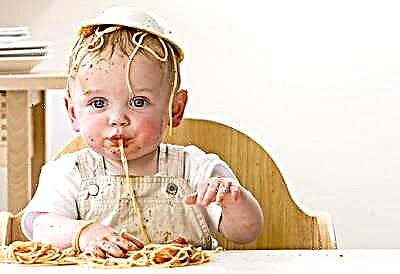
When the baby begins to try, in addition to mother's milk or a mixture of complementary foods, all food for the baby is ground and made homogeneous. Puree and liquid porridge are used to move the baby to thicker, and then to solid food.

Many mothers doubt at what age they can no longer give food crushed to a homogeneous state, but teach the crumbs to chew. Knowing the age at which the introduction of solid food into the diet is recommended is also important to prevent possible problems, for example, when a healthy baby at 3-4 years old refuses to eat in pieces or chokes when feeding.
When to introduce into complementary foods?
Neither the chewing apparatus nor the digestive system of infants in the first 4-6 months of life are ready for food other than breast milk or an adapted formula. In addition, in such young children, not only the sucking, but also the protective reflex is very pronounced, in which any solid objects are automatically pushed out by the tongue.
When the baby grows up, these innate reflexes begin to fade away. At the same time, the maturation of the baby's gastrointestinal tract continues, and the need for nutrients increases. At about the age of 4-6 months, babies are ready to taste foods with increased density.

Getting your child to eat thicker foods in a timely manner helps to teach the baby to bite, chew, and swallow dense foods. The nervous system of a six-month-old baby is already so developed that the baby can coordinate the movements of its tongue and swallowing movements. Even without teeth, your baby learns to grind and mix food in his mouth using his gums and tongue. To do this, dishes with different degrees of grinding of pieces should appear on his menu.
The optimal age for complementary foods with a denser consistency is called 6-10 months. If in this interval the parents are afraid to give the crumbs inhomogeneous food, its later introduction into the diet may cause the child to reject food in pieces. As a result, the child is unable to swallow solid food and chokes if the meal is not completely minced.
We recommend watching the release of Dr. Komarovsky's program, which details the topic of introducing complementary foods into the diet of babies:
How to transfer a child to solid food?
The transition from liquid and completely homogeneous food to solid food must necessarily be gradual. First, a liquid dish for crumbs is made semi-liquid, and then viscous and thick. In addition, over time, puree food is made finely chopped, and then they move on to medium chopping and large pieces.

The stages of the transition will be as follows:
- At the age of 4-6 months, depending on the type of feeding, babies begin to offer puree food from a spoon. All products at this age are given semi-liquid and without lumps, so that the baby can easily swallow them. Vegetable purees are wiped twice through a sieve or grinded with a blender at high speed, and the porridge is boiled from cereals ground into flour, offering a 5% dish first, and a little later - 10%.
- From 7-9 months of age, the consistency of the dishes for the child is made thicker. Vegetables are still offered to the crumbs in the form of mashed potatoes, but they are rubbed through a sieve 1 time or set a lower speed in the blender. For the preparation of cereals, you can already use cereals with medium grinding. The meat in the diet of infants of this age must first be homogenized (minced twice in a meat grinder, and then whipped in a blender with vegetable broth). At 9 months, boiled meat can only be passed through a meat grinder 2 times so that small pieces up to 2-3 mm remain in the puree.
- Also, at 8-9 months, the child begins to offer solid food in the form of cookies, crackers and wheat bread. Such dense products are given to the crumbs in the hand, allowing them to grind with cutting teeth. At the same time, the baby should be carefully watched, not allowing a situation when the baby chokes on a breakaway piece. For added safety, solid food can be placed in the nibbler.
- At the age of 10-12 months, it is time to accustom the child to less chopped meals. At this age, food for the baby is already crushed so that pieces of 3-5 mm in size remain in it. Fruits and vegetables for toddler can be kneaded with a fork or grated, and the meat can be cooked in the form of meatballs. Cereals for porridge are already used whole, but they boil it well. In addition, at this age, the child usually wants to take with his fingers and hold various objects, which allows you to offer the baby pieces of boiled vegetables, boiled pasta, small slices of white bread, slices of banana and other food that the baby can put in his mouth and chew on his own.
- A one-year-old child is improving his chewing skill and can already cope with cereal and vegetable casseroles, steamed cutlets and meatballs, grated fresh vegetables and fruits on a coarse grater, as well as with other dishes. By 1.5-2 years of age, the child is already fully chewing solid food.

If the child refuses
Some children are protesting against a denser meal and demand their favorite puree foods. This is often due to the transition to unmilled food too quickly. In addition, many babies are conservative and do not like to change their way of life, so they should be given time to get used to innovations.
Try changing the consistency of your baby's favorite food by aggressively offering a small amount every day.... At the same time, it is impossible to force the crumbs to eat so that the child does not develop a negative attitude towards thicker food and nutrition in general. The size of the pieces should be increased gradually and very slowly so that it is invisible for the baby.

If a child over one year old does not chew food in pieces, Dr. Komarovsky recommends:
- Offer the child to knead food on their own in their own plate, saying that there was no favorite puree in the store, and the blender does not work.
- Find something tasty among solid foods that your child will surely like, for example, fresh drying or slices of sweet fruits.
- Organize meals in a public place where the child can observe other children and be limited in food choices.
For how to teach your baby to chew, see the next video.
Find out if your child's weight is normal using the following calculator.



